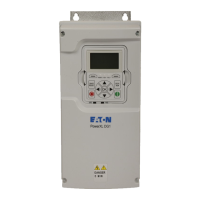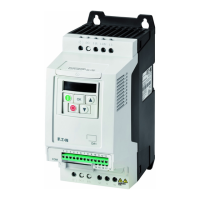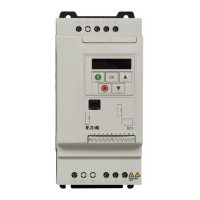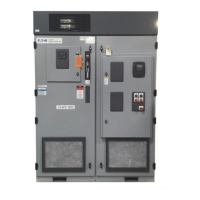Chapter 3—Product Overview
14 DG1 Series VFD MN040002EN—March 2014 www.eaton.com
Selection Criteria
The frequency inverter [3] is selected according to the supply
voltage U
LN of the input supply [1] and the rated current of
the assigned motor [2]. The circuit type (P/k) of the motor
must be selected according to the supply voltage [1]. The
rated output current I
e
of the frequency inverter must be
greater than/equal to the rated motor current.
Figure 8. Selection Criteria
When selecting the drive, the following criteria must be
known:
●
Type of motor (three-phase asynchronous motor)
●
Input voltage = rated operating voltage of the motor (for
example, 3 AC ~400V)
●
Rated motor current (guide value, dependent on the circuit
type and the supply voltage)
●
Load torque (quadratic, constant)
●
Starting torque
●
Ambient temperature (rated value 122°F [50°C])
When connecting multiple motors in parallel to the output of
a frequency inverter, the motor currents are added
geometrically—separated by effective and idle current
components. When you select a frequency inverter, make
sure that it can supply the total resulting current. If
necessary, for dampening and compensating the deviating
current values, motor reactors or sinusoidal filters must be
connected between the frequency inverter and the motor.
The parallel connection of multiple motors in the output of
the frequency inverter is only permitted with V/Hz
characteristic curve control.
If you connect a motor to an operational frequency inverter,
the motor draws a multiple of its rated operational current.
When you select a frequency inverter, make sure that the
starting current plus the sum of the currents of the running
motors will not exceed the rated output current of the
frequency inverter.
Switching in the output of the frequency inverter is only
permitted with V/Hz characteristic curve control.
Proper Use
The DG1 frequency inverters are electrical apparatus for
controlling variable speed drives with three-phase motors.
They are designed for installation in machines or for use in
combination with other components within a machine or
system.
After installation in a machine, the frequency inverters must
not be taken into operation until the associated machine has
been confirmed to comply with the safety requirements of
Machinery Safety Directive (MSD) 89/392/EEC (meets the
requirements of EN 60204). The user of the equipment is
responsible for ensuring that the machine use complies with
the relevant EU Directives.
The CE markings on the DG1 frequency inverter confirm that,
when used in a typical drive configuration, the apparatus
complies with the European Low Voltage Directive (LVD)
and the EMC Directives (Directive 2006/95/EC and
Directive 2004/108/EC).
In the described system configurations, DG1 frequency
inverters are suitable for use in public and non-public
networks.
A connection to IT networks (networks without reference to
earth potential) is permissible only to a limited extent,
because the device’s built-in filter capacitors connect the
network with the earth potential (enclosure). On earth free
networks, this can lead to dangerous situations or damage to
the device (isolation monitoring required).
To the output of the frequency inverter (terminals U, V, W)
you must not:
●
connect a voltage or capacitive loads (for example, phase
compensation capacitors)
●
connect multiple frequency inverters in parallel
●
make a direct connection to the input (bypass)
Observe the technical data and connection requirements. For
additional information, refer to the equipment nameplate or
label at the frequency inverter, and the documentation.
Any other usage constitutes improper use.

